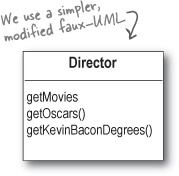This is a learning experience, not a reference book. We deliberately stripped out everything that might get in the way of learning whatever it is we’re working on at that point in the book. And the first time through, you need to begin at the beginning, because the book makes assumptions about what you’ve already seen and learned.
We use simple UML-like diagrams.
Although there’s a good chance you already know UML, it’s not covered on the exam, and it’s not a prerequisite for the book. So you won’t have to worry about learning EJB and UML at the same time.
We don’t cover every single picky detail from the spec.
The exam is pretty detailed, though, and so are we. But if there’s a detail in the spec that’s not covered in the exam, we don’t talk about it unless it’s important to most component developers. What you need to know to begin developing EJB components, and what you need to pass the exam, overlap about 95%. We cover a few things not on the exam, but we point them out so you don’t have to try to memorize them. And there is a very tiny percentage of details that might show up on the exam, but that we haven’t covered in detail. We created the real exam, so we know where you should focus your energy! If there’s a chance that this one picky detail might be on one question on the exam, but the effort to learn it isn’t really worth it, we might skip it, or cover it only very lightly, or only in a mock exam question.
The activities are not optional.
This is a learning experience, not a to-be-read book. The exercises and activities are not add-ons; they’re part of the core content of the book. Some of them are there to help with memory, some for understanding, some to help you apply what you’ve learned. If you’re serious about learning and remembering, and you want to pass the exam on the first try, don’t skip anything.
The redundancy is intentional and important.
One thing that’s distinctly different in a Head First book is that we want you to really really really get it. And we want you to finish the book remembering what you’ve learned. Most information or reference books don’t necessarily have retention and recall as a goal, but in this book you’ll see some of the same concepts come up more than once. Brain research shows that it usually takes a minimum of three “repeated trials” to get the content to move into your long-term memory storage.
The code examples are as lean as possible
It’s frustrating to wade through 200 lines of code looking for the two lines you need to understand. Most examples in this book are shown within the smallest possible context, so that the part you’re trying to learn is clear and simple. Don’t expect the code to be robust, or even complete. That’s your assignment for after you finish the book. The book examples are written specifically for learning, and aren’t always fully-functional. We have more detailed code samples on wickedlysmart.com.
Get Head First EJB now with the O’Reilly learning platform.
O’Reilly members experience books, live events, courses curated by job role, and more from O’Reilly and nearly 200 top publishers.


